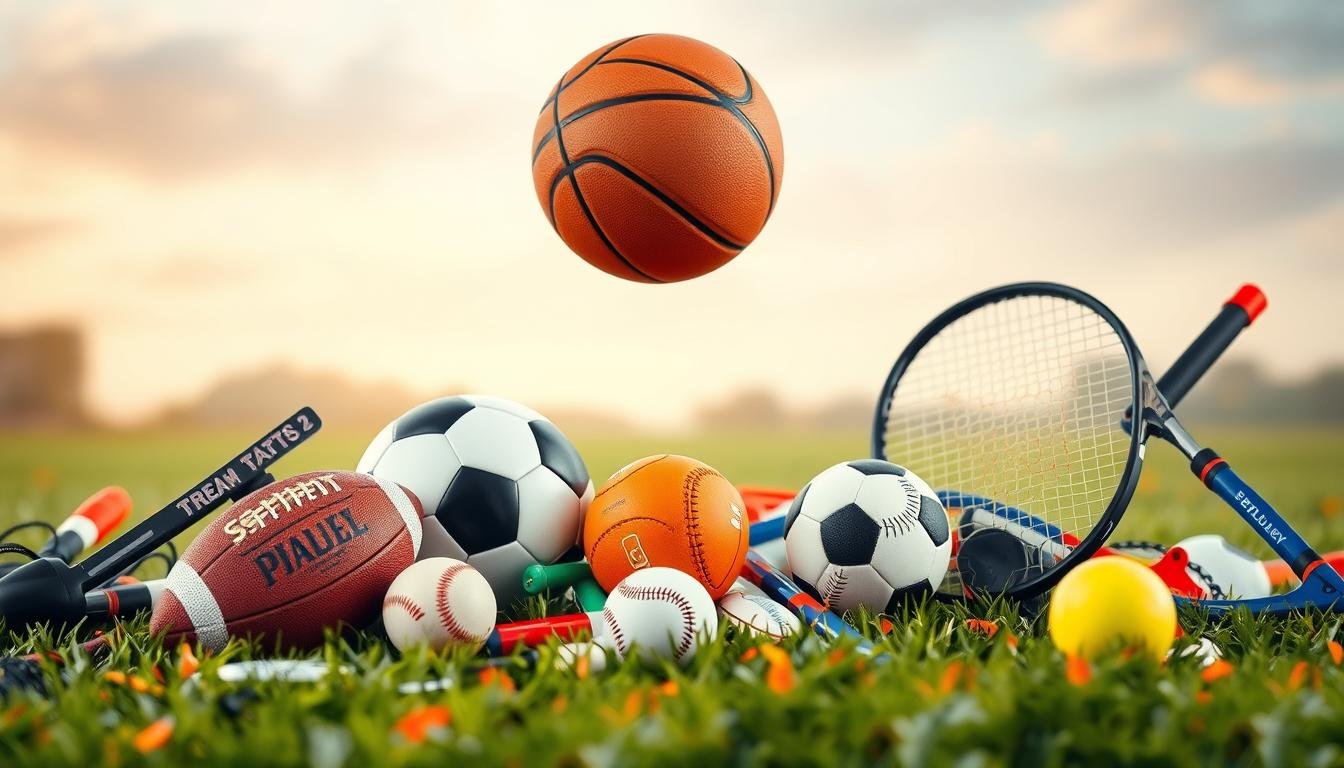Now Reading: Group Sports Vocabulary: Master the Lingo of Team Games
-
01
Group Sports Vocabulary: Master the Lingo of Team Games
Group Sports Vocabulary: Master the Lingo of Team Games

Group Sports Vocabulary: Master the Lingo of Team Games
Mastering the Lingo of Team Games: A Guide to Group Sports Vocabulary
Knowing the terms used in team sports is key for clear communication and enjoying the games. This article covers the vocabulary for popular team sports like baseball, cricket, hockey, basketball, American football, and soccer.

The next sections will explore the specific terms and phrases for each sport. This will give you a deep understanding of team game language.
The Significance of Sports Terminology
Knowing sports vocabulary is key for fans and players. It makes watching games or playing them more enjoyable. Understanding the terms used in different sports boosts the experience.
Why Understanding Sports Vocabulary Matters
Sports terms are more than words; they’re about culture and community. When fans get the language, they see the game’s strategies and details better.
How Terminology Enhances Game Appreciation
For viewers, knowing the terms makes the game more engaging. It helps fans follow the action, get the commentary, and enjoy the sport’s depth.
For Spectators and Fans
Knowing sports words makes watching games better. Fans can grasp the analysis and commentary, deepening their appreciation of the game.
For Players and Coaches
For those playing or coaching, knowing the terms is essential. It helps in planning strategies, explaining tactics, and team coordination.
Fundamental Sports Vocabulary
Knowing the basic sports vocabulary is key to enjoying team games. Whether you play, coach, or watch, knowing common terms makes the experience better.
Universal Terms Across Team Sports
Many team sports share common terms. These include words for player positions and the game’s structure.
Player Positions and Roles
Every sport has its own positions, but some terms are the same. For example, “captain,” “defender,” and “forward” are known across many games.
Game Structure Terminology
Knowing a game’s structure is important. Terms like “inning,” “quarter,” “half-time,” and “overtime” are used in different sports to mark game stages.
Equipment and Venue Vocabulary
Each sport has its own equipment and playing venues with specific names. For example, “field,” “court,” “pitch,” and “arena” are used for venues. “Ball,” “stick,” “racket,” and “goalpost” are for equipment.
| Term | Definition | Example Sport |
|---|---|---|
| Forward | A player who scores goals or points | Soccer, Basketball |
| Defender | A player who prevents the opposing team from scoring | Soccer, Hockey |
| Pitch | The playing field or area | Cricket, Baseball |
Baseball Terminology: America’s Pastime
Baseball is known as America’s pastime. It has its own special words that fans and players need to know. These words cover field positions, batting and pitching, and how the game is structured.
Field Positions and Player Roles
Each player has a role on the field. There’s the pitcher (P), catcher (C), and first baseman (1B). There’s also the second baseman (2B), third baseman (3B), shortstop (SS), and outfielders (LF, CF, RF). Knowing these positions helps fans understand the game’s strategies and roles.
Batting and Pitching Terms
Batting and pitching are key parts of baseball. Terms like strike, ball, swing, and pitch count are important. A home run (HR) is exciting, where the batter hits the ball out, scoring runs.
Scoring and Game Structure
The game is split into innings. Each team bats and fields. An out ends a player’s turn or their field time. Strategies like stealing bases and bunting need a good understanding of the game.
Innings and Outs
A game has nine innings. The team with the most runs wins. Outs can happen in many ways, like strikeouts, fly outs, and tag outs. Each shows different game situations and strategies.
Common Baseball Strategies
Teams use strategies like defensive shifts and bullpen management to beat opponents. Knowing these strategies helps fans see the game’s complexity and the decisions made by players and coaches.
Learning baseball terminology lets fans enjoy the game more. They can appreciate the game’s nuances and strategies, making baseball a favorite sport.
Basketball Lingo: On and Off the Court
Getting to know basketball lingo is key for anyone wanting to understand the game. It covers everything from court positions to game strategies. Basketball has its own special words for player roles, shooting methods, defense, and game plans.
Court Positions and Player Types
Each player has a role on the court, like the point guard, shooting guard, and center. These roles need different skills and play different parts in the game.
- Point Guard: usually the team’s best ball handler, responsible for bringing the ball up the court and setting up the offense.
- Shooting Guard: a scoring specialist who is adept at making shots from the perimeter.
- Small Forward: often considered the most versatile player, capable of scoring, rebounding, and defending.
Shooting and Defensive Terms
Players use various shooting techniques, like the jump shot and dunk. Defensive strategies include man-to-man, zone defense, and pressing.
Common shooting terms include “three-pointer” for shots made from behind the three-point line, and “free throw” for shots taken from the free throw line without being guarded.
Game Strategy Vocabulary
Coaches and players use special words to talk about game strategies. This includes offensive plays and defensive setups.
Offensive Plays
Offensive strategies include the pick-and-roll and fast breaks. The pick-and-roll is a basic play where a player sets a screen for a teammate, letting them drive or shoot.
Defensive Formations
Defensive teams use different setups, like man-to-man defense and zone defense. Man-to-man defense means each player guards a specific opponent. Zone defense means players defend a certain area of the court.
American Football Terminology: Downs and Drives
American football is filled with special terms. These terms cover gameplay, positions, and strategies. Knowing these terms helps players, coaches, and fans enjoy the game more.
Offensive and Defensive Positions
The offense and defense have their own jobs. Each has unique positions and tasks.
Special Teams Vocabulary
Special teams are key in American football. They have their own terms and ways of playing.
Soccer (Football) Vocabulary: The Global Game
The beautiful game, as it’s often called, has a rich vocabulary. It’s essential for understanding the sport. We’ll explore terms and phrases used in soccer. This includes field positions, ball control, and passing terms, as well as match structure and rules.
Field Positions and Formations
Soccer teams have 11 players on the field, each with a specific position. The positions are: goalkeeper, defenders (center backs and fullbacks), midfielders, and forwards (strikers and second strikers). Knowing these positions is key for team strategy and communication.
Ball Control and Passing Terms
Ball control is about keeping the ball. Key terms include dribbling, trapping, and passing. Dribbling is controlling the ball with your feet. Trapping is gaining control of a loose ball. Passing is kicking the ball to a teammate.
Match Structure and Rules
A soccer match has two 45-minute halves, with a 15-minute halftime break. The team with the ball is “in possession” or “on the ball.” A goal is scored when a player kicks or heads the ball into the opponent’s goal. The referee enforces the rules and keeps order during the game.
Set Pieces and Free Kicks
Set pieces are dead ball situations, like free kicks and corner kicks. Free kicks are given for fouls, handball, and offside offenses. These situations give a team a chance to score.
Tournament and League Terminology
Soccer competitions come in different formats, like league tournaments and knockout tournaments. League tournaments have a round-robin format, where teams play each other. Knockout tournaments have a single-elimination format, where losing teams are out of the competition.
Hockey Terminology: On the Ice and Field
Hockey is a fast-paced team sport enjoyed globally, with variations including ice hockey and field hockey. Understanding the terminology associated with hockey enhances appreciation and participation in the game.
Player Positions and Equipment
In hockey, each team has six players on the ice, including a goalkeeper. The positions are typically divided into forwards, defensemen, and a goalie. Forwards are often referred to as “offense” and are responsible for scoring goals.
Defensemen, or “defense,” play a crucial role in preventing the opposing team from scoring. The goalkeeper is a specialized position, focused on preventing the opposing team from scoring by defending the goal.

Game Play and Strategies
The objective of hockey is to score more goals than the opposing team by using various strategies. Teams often employ different tactics, such as forechecking and backchecking, to gain an advantage.
Players can use different types of shots, including wrist shots, slap shots, and backhand shots.
Penalties and Scoring
Penalties are awarded to players who break the rules, resulting in a stoppage of play and potential loss of possession. Common penalties include offside, icing, and goalie interference.
Goals are scored when a player successfully lands a shot on the opponent’s goal.
Power Plays and Penalty Kills
A power play occurs when a team has a man advantage on the ice due to an opponent’s penalty. Penalty kills are situations where a team must play shorthanded, trying to prevent the opposing team from scoring while being disadvantaged.
Ice vs. Field Hockey Differences
While ice hockey is played on ice rinks, field hockey is played on a grass or turf field. The rules, equipment, and strategies differ between the two variants. Ice hockey is typically played with a puck, while field hockey is played with a ball and stick.
Cricket Vocabulary: Wickets and Overs
Cricket has a lot of terms, from batting and bowling to field positions and match formats. Knowing these terms helps you understand the game better.
Batting and Bowling Terms
In cricket, batting means scoring runs, and bowling means delivering the ball. Key terms for batting include century (scoring 100 runs) and duck (scoring zero runs). Bowling terms include Yorker (a ball bowled at the batsman’s feet) and googly (a delivery that turns unexpectedly).
Field Positions and Player Roles
Cricket has many field positions, each with a specific role. The slip cordon is behind the wicket, and the cover region is on the offside. Players are batsmen, bowlers, or all-rounders, each with their own duties.
Match Format and Scoring
Cricket matches come in different formats, like Test matches and Limited Overs cricket. Test matches last for days, while Limited Overs include One-Day Internationals (ODIs) and Twenty20 (T20).
Test Matches vs. Limited Overs
Test matches focus on endurance and strategy over days. Limited Overs cricket is quick and intense. The scoring systems are different, with Test cricket allowing draws and Limited Overs having a fixed number of overs.
Cricket Equipment Terminology
Cricket equipment has its own terms. The bat is for batsmen, and the ball is the hard, leather-covered sphere bowled. Protective gear includes helmets, pads, and gloves, all important for safety.
| Term | Description |
|---|---|
| Over | A set of six deliveries bowled by a bowler. |
| Wicket | The dismissal of a batsman, or the physical structure of three stumps and two bails. |
| Century | A score of 100 or more runs by a batsman. |
Vocabulary Group Sports: Team Communication
Team success often depends on good communication. Sport-specific terms are key for strategy, action coordination, and quick decisions. They help teams work together smoothly.
On-Field Communication Terms
In team sports, players use special terms to talk on the field. For example, in soccer, “man on” warns teammates of an opponent. In basketball, “screen” or “switch” changes defensive plans.
Coach-to-Player Terminology
Coaches have their own way of talking to players, using hand signals and words. This is crucial for following game plans and making changes.
Signals and Calls
Coaches and players have agreed-upon signals and calls. In baseball, a hand signal might mean a bunt. In American football, quarterbacks call plays at the line, using specific words.
Strategy Discussion Vocabulary
Teams talk strategy with terms about player roles, opponent analysis, and plans. Knowing these terms is key for teamwork and strategy.

Learning team communication terms helps teams work better together. It’s important for players, coaches, and fans. A good sports vocabulary list is very helpful.
Sports Officiating and Rules Terminology
Knowing the terms used by referees and umpires helps us understand sports rules better. This section covers key terms and ideas in sports officiating.
Referee and Umpire Vocabulary
Referees and umpires are key in keeping games fair and following the rules in team sports.
Common Rules and Violations Across Sports
Many sports have similar rules, but some have their own. It’s important to know these rules and possible infractions for players, coaches, and officials.
Penalty and Foul Terms
In sports, penalties and fouls are given when rules are broken. Terms like foul, penalty, yellow card, and red card are common.
Game Clock and Timing Vocabulary
Managing game time is vital in many sports. Terms like game clock, timeout, and overtime help describe the game’s timing and pace.
Sports Slang and Idioms in American Culture
Sports slang and idioms are big in American culture. They shape our everyday talk and show our love for sports. Phrases like “slam dunk” and “home run” mean more than just sports terms. They carry a wide range of meanings.
Popular Sports Expressions
Terms like “full-court press,” “hat trick,” and “grand slam” are key in American English. They describe competitive moments, big wins, or hard efforts in sports.
Regional Sports Dialects
Different parts of the U.S. have their own sports dialects. “Touchdown” in football or “three-pointer” in basketball are tied to certain areas. They show local tastes and cultural identities.
Sports Metaphors in Business and Life
Sports metaphors are common in business and daily life. They help explain complex ideas and feelings. Sayings like “playing hardball,” “being on the same team,” or “striking out” describe competition, teamwork, or failure.
Conclusion
Understanding the vocabulary of group sports is key to enjoying team games more. We’ve looked at the importance of sports terms in baseball, basketball, and more. Knowing these terms makes your game experience better and connects you with the sports world.
Learning the specific words and phrases for each sport helps you talk better with teammates and coaches. It also lets you understand game strategies and tactics. This makes your game experience more fun and rewarding.
The language of sports keeps changing, shaped by culture, society, and technology. Keeping up with new sports terms helps you stay connected to the sports world. It keeps you informed and engaged with the latest in sports.
In short, knowing sports vocabulary is crucial for any sports fan. It makes you more informed and involved in the game. By learning the unique terms of your favorite sports, you’ll enjoy the game more.
FAQ
What are some common terms used across different team sports?
Terms like “team,” “player,” “game,” “score,” and “match” are used in many sports. This includes baseball, cricket, hockey, basketball, American football, and soccer.
How does understanding sports terminology enhance the game experience?
Knowing sports terms makes watching games more fun for fans. It helps them understand the game better. For players and coaches, it improves how they talk and make decisions.
What are some fundamental terms used in team sports?
Key terms in team sports include player roles and game structure. For example, in baseball, you have “pitcher,” “batter,” “inning,” and “strike.” In soccer, terms like “goalkeeper,” “defender,” “midfielder,” and “forward” are common.
What are some key terms used in baseball?
Baseball terms include “pitch,” “at-bat,” “inning,” “strike,” “ball,” “hit,” “run,” “score,” and “inning.” Player positions like “pitcher,” “catcher,” “first baseman,” and “second baseman” are also important.
What are some key terms used in basketball?
Basketball terms include “point guard,” “shooting guard,” “small forward,” “power forward,” “center,” “rebound,” “block,” and “assist.” Terms like “pick and roll,” “post play,” and “fast break” are used in game strategy.
What are some key terms used in American football?
American football terms include “offense,” “defense,” “quarterback,” “running back,” “wide receiver,” “lineman,” and “kicker.” Game strategy terms like “play call,” “play action,” and “blitz” are also used.
What are some key terms used in soccer?
Soccer terms include “goalkeeper,” “defender,” “midfielder,” “forward,” “pass,” “shot,” and “goal.” Terms like “formation,” “tactics,” and “set piece” are used in game strategy.
What are some key terms used in hockey?
Hockey terms include “goalie,” “defenseman,” “forward,” “center,” “winger,” “assist,” and “goal.” Terms like “power play,” “penalty kill,” and “breakaway” are used in game strategy.
What are some key terms used in cricket?
Cricket terms include “batsman,” “bowler,” “fielder,” “wicket,” “over,” and “run.” Terms like “test match,” “one-day match,” and “Twenty20” relate to game format.
How does sports terminology influence everyday speech?
Sports terms often show up in everyday talk. Terms like “slam dunk” and “hat-trick” are used in non-sports contexts.
What are some regional sports dialects?
Different regions have their own sports terms. For example, “grand slam” and “perfect game” mean different things in different places.






























